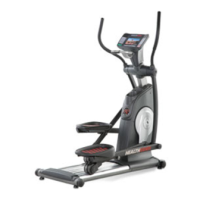
Do you have a question about the Healthrider 8.5ex Crosstrainer Elliptical and is the answer not in the manual?
| Brand | Healthrider |
|---|---|
| Model | 8.5ex Crosstrainer Elliptical |
| Category | Elliptical Trainer |
| Language | English |
Provides contact details for customer support, including phone numbers and website for assistance and parts.
Emphasizes the need to note the product model and serial number before contacting support.
Details the location of the warning decal and how to request a replacement if missing or illegible.
Lists critical safety warnings such as user weight limits, child safety, and pedal spinning hazards.
Advises consulting a physician before starting exercise and highlights owner's responsibility for user awareness.
Specifies home-use only, indoor placement, level surface, and clearance requirements for safe operation.
Covers regular part inspection, child/pet safety, weight limits, appropriate attire, and stopping procedures.
Thanks the user for their purchase and directs them to register the product online for warranty service.
Identifies and labels the main parts of the elliptical exerciser shown in a diagram.
Details requirements for assembly, including needing two people and specific tools like screwdrivers and wrenches.
Provides visual identification and key numbers for all hardware components used during assembly.
Instructions for connecting a 75 ohm CATV cable to the elliptical exerciser for television reception.
Guides on connecting external sources like cable boxes or VCRs using a CATV cable.
Steps to connect a DVD player or VCR to the console's audio/video input jack using an RCA cable.
Details how to properly connect the power supply to the elliptical exerciser and a suitable outlet.
Provides instructions for safely moving the unit, emphasizing the need for two people.
Guides on mounting, pedaling, and maintaining a continuous motion, including crank arm cover rotation.
Explains how to adjust leveling feet to ensure the exerciser remains stable and does not rock during use.
Describes the console's features like manual mode, preset programs, heart rate control, and custom programs.
Explains how to enjoy the personal television while exercising and connect external video sources.
Provides page references for using manual mode, preset programs, heart rate programs, and custom programs.
Instructions on turning on the console and selecting manual mode, ensuring the track graphic appears.
Details how to use the OneTouch Resistance buttons to change resistance levels during exercise.
Explains the various exercise metrics displayed on the console, such as time, distance, RPM, and calories.
Guides on how to use the handgrip pulse sensor for accurate heart rate readings during workouts.
Describes how the console automatically turns off after a period of inactivity or when exercise ceases.
Instructions for choosing one of the 20 preset programs and starting the workout session.
Explains how the console indicates progress, target pace, and resistance level changes during a program.
Details how to manually adjust resistance during a program, noting that it will reset at the next segment.
Guides on selecting heart rate programs and setting target heart rate zones for effective training.
Explains the importance of holding the pulse sensor and how the console adjusts resistance based on heart rate.
Details how to set resistance and pace for 40 one-minute segments to create personalized workouts.
Instructions on finishing, saving, and potentially modifying custom programs after completion.
Explains how to adjust resistance and pace mid-workout and how these changes are stored for the next segment.
Steps for turning on the TV, selecting channels, and adjusting volume using the console buttons.
Instructions for connecting and operating external video sources like DVD players and VCRs via CATV or AV input.
How to access and adjust TV settings like brightness, contrast, color, and sharpness.
Guides on adding/deleting channels, selecting cable settings, and saving channel memory.
Information on how to turn the demo mode on or off, which affects automatic console shutdown.
Instructions for regular inspection, tightening parts, cleaning the unit, and keeping the console dry.
Provides guidance on resolving issues with heart rate display, referring to specific steps on page 16.
Steps to adjust the drive belt if pedals slip, including locating the idler screw and testing adjustments.
Addresses common causes of poor TV reception like interference, ghosts, and weak signals.
Troubleshooting steps for when neither the console nor the TV displays any image, checking power connections.
Solutions for when the console works but the TV screen remains blank, checking cable connections.
Resolves problems with sound or picture when connecting DVD players or VCRs, checking modes and cables.
Explains how to use heart rate to determine intensity levels for fat burning and aerobic exercise.
Provides recommendations for warming up, training zone duration, and cooling down phases of workouts.
Suggests workout frequency for maintaining or improving fitness, emphasizing consistency.
Instructions for performing a toe touch stretch to improve hamstring, back of knee, and back flexibility.
Detailed steps for a hamstring stretch, targeting hamstrings, lower back, and groin muscles.
Guide to stretching calf and Achilles tendons, including variations for deeper stretching.
Instructions for a quadriceps stretch, focusing on quadriceps and hip muscles, with balance tips.
Steps for performing an inner thigh stretch, targeting quadriceps and hip muscles.
Comprehensive list of all parts with their corresponding key numbers and quantities for identification.
Visual representation of the elliptical exerciser's main components and their assembly order.
Detailed exploded view illustrating the assembly of pedals, handlebars, and related components.
Specifies the required product and part information needed when contacting customer service for replacement parts.
Details the warranty period for the product, resistance mechanism, and frame, and conditions for coverage.
Outlines what is not covered by the warranty, including damage from misuse, freight, or commercial use.
Informs users about specific legal rights granted by the warranty and how they may vary by state.
